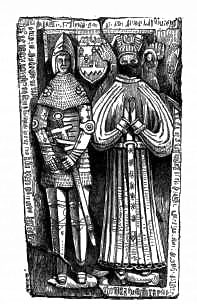Battle on St. Callixtus' Day
"When the Viceroy was aware of the advance of the Scots towards the Pale, he assembled a great army, said to amount to '20,000 trappit horse,' and an equal number of foot.
"The approach of this immensely superior force did not dishearten the brother of the lion-hearted King of Scotland. He declared he would fight were they sixfold more numerous.
"In vain his officers and allies counselled caution; in vain the Irish chiefs recommended him to avoid a pitched battle, and harass the enemy by skirmishing. Edward indignantly bade them 'draw aside, and look on,' which Barbour declares they did. A very interesting account of the battle on St. Callixtus' day is given in the Ulster Archaeological Journal. The battle was on Sunday, 14th October, 1318. According to Barbour, Edward Bruce had a presentiment of his death, and would not use his usual coat-armour. The legend is, that having the idea the fall of King Edward Bruce would decide the battle, Sir John Bermingham, leader of the Anglo-Irish army, disguised himself as a friar, passed into the Scottish camp, and, being shown the king, who was hearing Mass, craved alms, so as to induce Bruce to look up from his prayer-book. This gave Bermingham the opportunity of marking well his face, in order to single him out in the fray. The king ordered relief to be given to the importunate friar; but the eager glance of the intrusive applicant so disquieted him—agitated, doubtless, from the idea of his small force being about to engage at such desperate odds—that he presently caused the attendants to look for the friar, but he was nowhere to be found. This caused him to array one Gib Harper in his armour, and appoint Lord Alan Stewart general of the field.
The fight commenced with a rapid charge on the Scots by the Anglo-Irish under Bermingham. With him were divers lords and a great army. The force was chiefly composed, however, of yeomanry, or, as an ancient record says, 'the common people, with a powerful auxiliary dextram Dei.' Bermingham, believing Lord Stewart was Bruce, singled him out, and, after a terrible combat, slew him, whereon the Scots fled. According to the Howth Chronicle, few escaped, their loss being 1,230 men. Bruce's death is generally ascribed to John Mapas, one of the Drogheda contingent. The Ulster Journal states:—'There can be little doubt that the ancient Anglo-Irish family of "Mape," of Maperath, in the shire of Meath, was descended from this distinguished slayer of Edward Bruce.' The heiress of John Mapas, Esq., of Rochestown, county of Dublin, was married to the late Richard Wogan Talbot, Esq., of Malahide. After the defeat at Dundalk, the small remnant of the Scottish invaders yet alive fled northward, where they met a body of troops sent by King Robert as a reinforcement to his brother. They could not make head against the victorious troops of Bermingham, so they made their way to the coast, burning and destroying the country through which they passed."

Butler's Tomb, Friary Church, Clonmel
